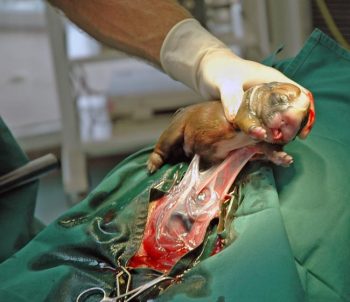Now most female canine patients are spayed, it comes as no surprise reproductive emergencies are not as common.
One confusion seems to be not knowing how to determine a true dystocia emergency – especially when given advice over the telephone – from the process of normal parturition.
Another concern is how to confidently form a diagnostic pathway to determine the cause of dystocia – especially for reasons other than obvious physical abnormalities (for example, fetopelvic disparity and fetal malposition).
Often, once we decide to go down the medical treatment pathway – whether the result of findings or owner/financial constraint – no one is confident as to what medication should be used and how often drugs can be given safely.
This series of blogs will address these issues in a step-by-step manner. Hopefully, by the end, you will be confident in the diagnosis and management of dystocia.
Labour stages
Before moving on to the signs of dystocia, let’s go through the signs of labour.
First stage labour
First stage labour is characterised by panting, tremoring, nesting behaviour, a drop in core temperature – usually a drop by almost 1°C 24 hours prior to second stage labour – and a drop of progesterone to below 2mg/ml.

- dogs: approximately 6 to 12 hours
- cats: approximately 6 to 24 hours
Second stage labour
Second stage labour is landmarked by the water breaking, visible abdominal contractions, and the allantoic/amniotic sac or fetal parts visible from the vulva.
If vulval discharge is present, they should be clear. Excessive amount of bright red haemorrhage, green or black discharge prior to delivery, or purulent material can indicate a pathological process requiring immediate veterinary attention.
- dogs: approximately 3 to 6 hours
- cats: approximately 6 to 24 hours
Third stage labour
Third stage labour this is when passage of all the placenta has occurred, generally within 15 minutes after passing a puppy or kitten.
Clues
Now we understand the normal progression of parturition, a few clues exist in the history that could suggest dystocia may be present.
Some breeders will often know the ovulation timing of the patient – especially if AI was performed. Tests such as progesterone levels, luteal hormone (LH) levels, cytology and vaginoscopy are some ways where it can help time the ovulation.
The normal gestation length should not be any longer than 66 days from the LH surge or, if the ovulation history is unknown, 72 days from the last known breeding.
History of prior dystocia is a warning, as most animals with prior parturition difficulties are more likely to develop dystocia again.
The same goes for animals that have previously required a caesarean. Their risk of requiring future caesareans is high, with further risk of uterine rupture if dystocia happens again.

Intervention signs
Owners often telephone after the failure of normal progression of delivery. The signs that always require immediate intervention are:
- more than 4 hours have passed from the rupture of the first chorioallantois
- more than 2 hours between delivery
- more than 30 minutes of strong abdominal contraction and no delivery
- presence of green or black discharge before delivery
- large amount of bright red haemorrhage
- abnormal amount of pain during contractions
- collapse of the bitch or distracted mothering
Any of these signs require immediate presentation to the veterinarian. Delivery of stillborn puppies is also an indication where veterinary attention is indicated.
Finally, if owners are concerned, it is best to advise veterinary assessment rather than try to convince them everything is okay based on what they describe over the telephone.

Leave a Reply